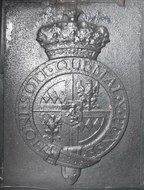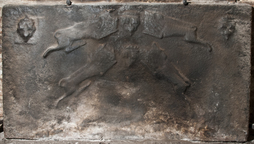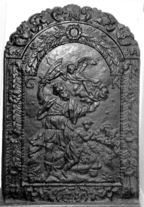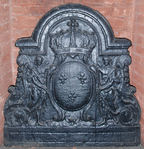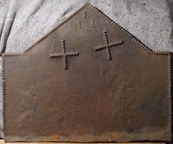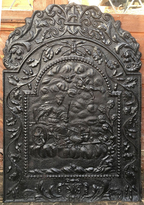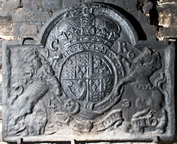-
1217
Description: Rectangular shape; no edging; shield of the 2nd Duke of Montagu surrounded by the Garter and surmounted by a ducal coronet.
Notes: One of 23 firebacks at Boughton House, Northamptonshire, cast with the ducal arms and the Garter having a diameter of 48cm. Fifty firebacks were cast for the house between 1743 and 1748 by Richard Ford, probably at Nibthwaite Furnace, but also possibly at Newland furnace, both then in north Lancashire. The arms are blazoned: Quarterly, 1st & 4th: Argent, three fusils conjoined in fess gules, a bordure sable (Montagu); 2nd & 3rd: Or an eagle displayed vert beaked and membered gules (Monthermer); on an escutcheon of pretence, Sable a lion rampant Argent a canton Argent charged with a cross Gules (Churchill); John, 2nd Duke of Montagu married Mary, daughter and co-heiress of John, 1st Duke of Marlborough.
Copies of this fireback are known.
Inscription: HONI.SOIT.QUI.MAL.Y.PENSE
Arms: Montagu quartering Monthermer with Churchill in an escutcheon of pretence - John Montagu, 2nd Duke of Montagu, KG
- Decoration tags:
- rectangular (shape)
- none (edging)
- carved pattern panels
- heraldic
- armorial
- text
Manufactured: in the mid-18th century probably at Newland Furnace in the Furness area of England.
Current location: Boughton House, Geddington, Northamptonshire, England.
- Attached to series:
- Montagu arms series
- Personal armorial firebacks
-
1240
Description: Rectangular shape; twisted rope edging (top and sides); top centre, crowned shield bearing initials KH above a fleur-de-lys between an angled leopard passant guardant sinister (on the left) and an angled leopard passant (on the right); the group repeated below at a steeper angle; in each top corner, a crowned shield bearing initials KH, above a fleur-de-lys, the left shield over pressed.
Notes: One of a large series employing distinctive Tudor heraldic stamps. The absence of one of the legs of the leopard passant indicates that this is an example of a later use of the stamp, earlier castings showing the stamp in more complete condition. The only examples of this fireback that have been noted are similarly poor copies lacking definition. Other examples are at Sackville House, East Grinstead and at Nymans, Handcross, both in Sussex.
Copies of this fireback are known.
Inscription: KH [x4]
- Decoration tags:
- rectangular (shape)
- rope (edging)
- simple stamps
- carved stamps
- heraldic
- royal
- text
- objects
Manufactured: in the mid- to late-16th century in the Weald area of England.
Current location: in private hands, Hartfield, East Sussex, England.
- Attached to series:
- Royal series
-
139
Description: Arched rectangular shaped central panel with bead-and-pellet edging; figure of Abraham, a scimitar in his raised right hand, which is being restrained by an angel emerging from a cloud; Isaac is kneeling to Abraham's left and a ram is caught in a bush to the left of the plate; the initials are in the top corners; arched rectangular shaped border with fillet edging, and swags of leaves suspended from flowers; on top, symmetrical foliate swirls.
Notes: The design is an adaptation of an engraving by Adriaen Collaert (1555-1623) of a painting by Maarten de Vos (1532-1603), Plate 5 of The Story of Abraham. In the 'Thesaurus sacrarum historiarum veteris testamenti', published in Antwerp by Gerard de Jode (1509-1591) in 1579, 1585 and, subsequently, by Visscher in 1589. One of a small group of firebacks, all of similar shape, some with biblical designs, others mythological, all dated around 1700 and bearing the letters GK. Formerly part of the Ade Collection (from Grove Hill, Hellingly, Sussex).
Copies of this fireback are known.
Inscription: G K / 1700
- Decoration tags:
- 'Dutch' (shape)
- fillet (edging)
- whole carved pattern
- individual letters
- biblical
- text
- humans
Manufactured: in 1700 in the Siegerland area of Germany.
Current location: Hastings Museum and Art Gallery, John's Place, Bohemia Road, Hastings, East Sussex, England.
Museum number: HASMG: 1952.51.37 (part of the Hastings Museum museum group)
Citation: Lloyd, N., 1925, 'Domestic Ironwork I', Architectural Review, 58, pp. 58-67.
- Attached to series:
- 'Dutch' GK series
- Old Testament & Apocrypha firebacks
- Abraham & Isaac firebacks
-
828
Description: Upon a rectangular base plinth with an inscribed rectangle, to each side, a wide foliate scroll; central cartouche behind an oval shield bearing three fleurs-de-lys over a horizontally textured ground, supported on each side by a draped male figure, the whole surmounted by a French royal crown; on top, an arch rising from horizontal moulding on each side.
Notes: Characteristic of designs illustrated by architects such as Daniel Marot; the texturing on the shield indicates the azure tincture.
Arms: French royal
- Decoration tags:
- rectangular with round arch (shape)
- complex individual (edging)
- whole carved pattern
- planklines
- armorial
- royal
Manufactured: in the late-17th to early-18th century in France.
Current location: in private hands, Lewes, East Sussex, England.
- Attached to series:
- Foreign armorial firebacks
-
958
Description: Rectangle with triangular arch; twisted rope edging (top and sides); centre top, initials in triad, E above; two twisted rope crosses irregularly spaced below initials.
Notes: The initials, probably of a husband and wife, show minimal extension in the horizontal, although the 'I' has a stud halfway; the crosses almost certainly have an apotropaic purpose; the depth of the casting varies between the top, where it is thickest, and the bottom. Bellman's auction, Wisborough Green, 13 Oct 2021, lot 589 (£420).
Inscription: IEL [triad]
- Decoration tags:
- rectangular with triangular arch (shape)
- rope (edging)
- simple stamps
- carved stamps
- apotropaic
- text
Manufactured: in the late-16th to early-17th century in England.
Current location: not known.
- Attached to series:
- Rope design firebacks
-
1059
Description: Arched rectangular central panel with bead on broad fillet edging; pictorial scene of a figure in a chariot on left, drawn across clouds by two peacocks; above, a putto and a bird flying in clouds; to the right, a tree; arched rectangular border with fillet edging; symmetrical undulating oak fronds descending from a loop; at the bottom, the letter W in a cartouche between swirled foliage; on top, mirrored swirled foliage descending from a loop.
Notes: The figure is likely to be that of Hera/Juno, who is traditionally associated with peacocks. The initial 'W' probably identifies the pattern maker; a single vertical line right of centre indicates the join between two boards that formed the pattern. The 'W' initial probably denotes the pattern maker.
Inscription: W
- Decoration tags:
- 'Dutch' (shape)
- fillet (edging)
- whole carved pattern
- planklines
- pictorial
- allegorical
- text
- humans
- plants
- objects
Manufactured: in the late-17th to early-18th century in England.
Current location: not known.
- Attached to series:
- British 'Dutch' style firebacks
- W series
-
1303
Description: Arched rectangular shape; cavetto edging; armorial; Stuart English royal arms within a circular garter; crown, motto and supporters (crowned lion and unicorn); initials separated by cro wn; date - 1643 - inserted outside Garter.
Notes: A widely copied fireback with the date, 1643, probably spurious, inserted when copied. An earlier casting without the date is no. 350.
Inscription: C R / 1 6 / HONI SOIT QVI MAL Y PENSE / 4 3 / DIEU ET MON DROIT
Arms: English Stuart royal
- Decoration tags:
- rectangular with round arch (shape)
- cavetto (edging)
- whole carved pattern
- individual numbers
- heraldic
- armorial
- royal
- text
Manufactured: in the mid-17th century in England.
Current location: in private hands, Worth, West Sussex, England.
- Attached to series:
- Carolean royal armorial firebacks
- Stuart royal armorial firebacks
